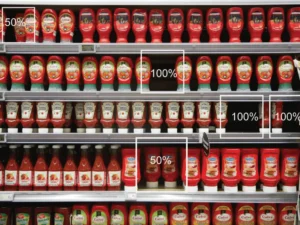The age of perfect customer experience is upon us. Although many shoppers turned online, physical stores are still the best way to convey the brand’s message and present your products. Top level brands invest a lot into carefully crafted ‘retail experiences’. So why does shopping at an Apple store or Nike shop makes you feel good?
Introducing retail footfall analytics. For a long time this technology was only available for high spenders. Computer vision solutions for footfall analysis finally made it available to smaller retailers too.
Computer Vision powered Retail Footfall Analytics
Computer vision analyses video feed from in-store security cameras. It can track customer football across the store, provide footfall count analysis – for instance, how much time customers typically spend in this isle, how much time they spend browsing for items, how many eyeballs does an advertisement poster attract and many more.
What makes Computer vision based footfall analysis so effective is that no additional hardware is required to make it work! The store does not need to install footfall sensors, retail traffic counters, smart tags on items and other additional hardware. It does not need to rely on WiFi football analytics data, which is not effective for small retail spaces.
How to fix my in-store experience?
- Optimizing store layout
E-commerce vendors drill down on their store efficiency. Do the items on my homepage convert into sales? How many items per page should be shown? What items to present first?
Notice the pattern? You can only learn by experience. Online retailers experiment a lot. Now Computer vision footfall analytics software allows to conduct such experiments in physical store realm.
As Computer vision footfall tracking software does not rely on sensors, tags or dedicated hardware, you may experiment as much as you want. Does this dress in the store window attract more eyeballs? How large the font advertising discounts should be? Does this product isle in the beginning of the store block customer flow further into store?
You should begin with a spaghetti diagram of customer flow throughout the store. This way you can identify “cold” and “hot” areas, as well as foot-traffic patterns. This will help to at least identify where flow could be optimized. In addition, footfall analytics can identify the customers, whose journey throughout the store ended at the cash register – maybe there is a common pattern of their behaviour? Maybe there is a possibility for store layout to “nudge” the customers in particular direction?
With in-store data comparable to Google Analytics, you may analyse, test and experiment as you please.
- Choice is King – but Less is More
Recently H&M reduced the number of items they carry in some of the retail stores, calling the experiment as ‘decluttering’. With less choice, focusing on best-selling items, they managed to increase sales per store. Sometimes less is really more.
Does your store feel cluttered? With footfall analytics, you can measure the average time in store, the average time spent browsing for items – same way online retailers do. Connecting this information with checkout data, you may clearly identify whether longer time in-store converts into higher sales; or on the contrary, identify that customers value a fast shopping experience.
- Kill the bottlenecks
Every store has a bottleneck – the check-out counter. But rarely do retailers know how much time customers spend in queues. For e-commerce, this is a no-brainer. One-click checkout is an epiphany to avoid cart abandonment. The check-out should be fast and fluent.

With footfall analytics software, you may easily identify the queue wait times at certain times of the day, weekends/weekdays, what is the queue size and how many shoppers quit waiting and abandoned their carts. By connecting this data with sales management software, retailers may quantify the loss of income. Plus, it is the most effective tool to plan employee shifts.
Bottlenecks can occur in different parts of the store. Maybe there are too few fitting rooms at an apparel store. Or too few shop assistants service the customers during peak times. Retail footfall analytics can clearly identify and quantify such problems.
Want to craft a perfect shopping experience?
Computer vision based footfall analysis works for small (think boutique store), as well as large retail areas (multiple-storey shopping mall). Software as a service model and pay-as-you go plans makes modern footfall analysis affordable for all customer types.
Are you ready to take your customer experience to the next level?
Get in touch with us!
Not Sure How AI Can Help Your Business? Let’s Talk!

Ugnė Daniūnaitė
Business Development Manager
Book a no-obligation free consultation with our expert.



